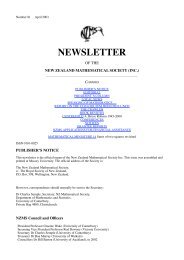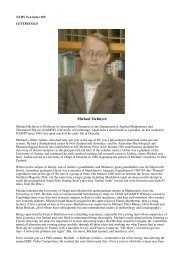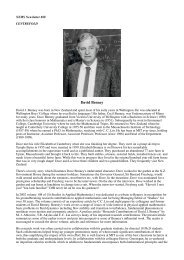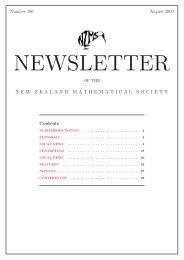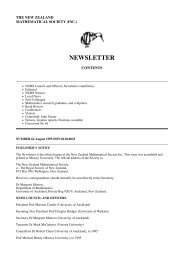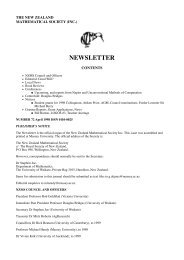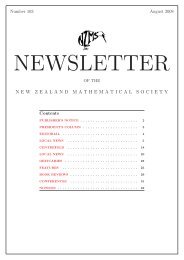newsletter - New Zealand Mathematical Society
newsletter - New Zealand Mathematical Society
newsletter - New Zealand Mathematical Society
You also want an ePaper? Increase the reach of your titles
YUMPU automatically turns print PDFs into web optimized ePapers that Google loves.
Then the rains came. Large parts of the Manawatu were flooded. The Manawatu River turned into a<br />
raging, angry and thundering river. It was quite a spectacular sight to drive over the bridge to work on the<br />
16th of February. The walking tracks and adjacent low-lying farmland had become part of the river. Then<br />
the rumours started. It was conjectured that the flow had become too much for the bridge and that there<br />
were concerns regarding the structural integrity of the Fitzherbert Bridge. Another was that the bridge<br />
was going to be closed to pedestrians. All these rumours started about 11.00 am. The upshot was that<br />
schools were closed so that pupils and staff could get home. Even Massey staff was allowed to leave so<br />
most went home. Unlike Hamilton we have only one bridge so a collapsed bridge would have been<br />
disastrous. The need for a second bridge has been an ongoing saga for two decades or so and a decision is<br />
not in sight. Two mathematicians were affected namely Bob Richardson and Bruce van Brunt.<br />
Professor Bob Richardson from Appalachian State University, Boone, North Carolina returned to <strong>New</strong><br />
<strong>Zealand</strong> in December for another six months. As he lives in Pahiatua (on the other side of the hills), he<br />
became an isolated singularity for one day when the three roads connecting west and east were closed on<br />
the 16th. Currently two roads are still closed. Heavy traffic that used to go through the Manawatu Gorge<br />
now crosses the Tararua Ranges via the Pahiatua track, a road not at all suitable for milk tankers and<br />
articulated trucks. It took Bob a good two hours to cover a distance of 35km and the only way to get to<br />
Massey on time is to leave Pahiatua before the heavy traffic starts.<br />
Bruce was an isolated singularity for two days. He lives in the Pohangina Valley north of the village.<br />
Bruce set out to go to Palmerston North on the 15th but wisely decided to return home when he saw the<br />
rapidly rising Pohangina River. Trouble was evident as it still rained hard. As it happened a big part of the<br />
road had been washed away causing a very big hole in the road. The road on the other side on the valley<br />
was also impassible. On the Wednesday Bruce managed to scramble down into the hole, walked through<br />
mud and debris and climbed got out of it again. From climbing mountains (maxima) a reversal to<br />
crawling into and out of holes (minima). Luckily he managed to hitch hike to Massey.<br />
Robert has supervised for six months Bård Skaflestad, a PhD student from the University of Trondheim.<br />
While he was here he witnessed many extreme climatic weather conditions get broken. His home is well<br />
north of the Polar Circle and he could tell us all about the dark, long winter. B\aa rd went back to Norway<br />
early March.<br />
We welcome Matthew Hardy as a Massey University Postdoctoral Research Fellow. Matthew has<br />
commenced a postdoctoral research project in computational mathematics. Working with Igor, Matthew<br />
will investigate the parallel implementation of monotone methods for singular perturbation methods.<br />
Matthew's PhD, undertaken at Oxford University, comprised numerical studies of gas-powered microparticle<br />
propulsion devices. Previously, Matthew completed a BSc(Hons) in Pure Mathematics at the<br />
University of Sydney.<br />
For the Allan Wilson Centre Mike Hendy reports:<br />
Doom04<br />
The mathematicians of the Allan Wilson Centre joined with the biologists at their annual workshop in<br />
phylogenetics, which this year was held at Whakapapa (Mount Doom)—participants queried whether it<br />
should be renamed "Gloom04" —as we were in rain or mist for most of the five days, or "Boom04", as<br />
the venue was struck by lightning on the last night. For most of that week we were isolated from the<br />
lower North Island by the torrential rains and high winds that devastated the region at that time. However<br />
the consolations included that we were able to witness spectacular waterfalls (overflowing gutterings) and<br />
swollen rivers (across the walkway between the accommodation block and the meeting room) and enjoy<br />
some excellent science. This year's participant numbered 54, and included a number of old friends as well<br />
as new vistors from overseas, including some new-comers, from France, Germany, Sweden, Israel,<br />
Russia, Australia, Canada, and United States. (Details, including abstracts can be viewed at<br />
http://www.math.canterbury.ac.nz/bio/doom04/doom04_programme.pdf.)<br />
Helix<br />
Our High Performance Computer, Helix, is currently being expanded with the addition of 12 Opteron<br />
(64-bit) nodes, and we are planning further expansion in the near future. Although usage is growing, there<br />
is still an opportunity for other NZ researchers to buy time on our facility. (For details contact Mike<br />
Hendy (m.hendy@massey.ac.nz).<br />
INCOB<br />
The International Conference on BioInformatics 2004 is being hosted jointly by the Allan Wilson Centre,<br />
and the Bioinformatics Institute, The University of Auckland, and is to be held at the Aotea Centre,




